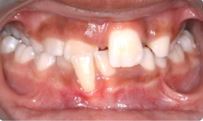Burlingame Smile Studio, proudly serving Burlingame, invites patients from San Bruno, Hillsborough, and Millbrae to visit.
There are many different reasons why a patient may require orthodontic care. Some of the most common orthodontic needs we see at Burlingame Smile Studio include:
Missing Teeth
Missing teeth is a common problem that can cause improper function, uneven wear, and poor alignment. Of course, missing teeth also results in a less appealing smile and difficulties with chewing and speech.
Dr. Lee can close spaces between the teeth with braces or other orthodontic appliances. Another way to resolve missing spaces is by creating more space with orthodontics to prepare for tooth replacement.
Missing Teeth Before & After


Crowded Teeth
Crowding of the teeth can be caused by improper eruption of the teeth or untimely loss of the primary teeth, and it causes problems such as:
- Twisted or displaced teeth.
- Disharmony between the jaw and teeth.
- Hard-to-clean teeth that are susceptible to decay and disease.
- Improper function of the teeth.
- A less confident smile.

Gaps Between Teeth
Spacing is the opposite of crowding. This happens when the teeth are too small to fill the available space. It can also be caused by abnormal tissue attachments or missing teeth. Dr. Lee can correct widely spaced teeth with orthodontics and help you avoid poor dental function and aesthetics.

Impacted Teeth
Impaction occurs when a tooth cannot erupt into the mouth, and instead becomes lodged below the gums. Impacted teeth can be caused by poor positioning of developing tooth buds, early loss of primary teeth, or overcrowding of the teeth.
Why should you correct impaction with orthodontics? Orthodontics will:
- Protect the root structure of the surrounding teeth.
- Help you avoid the discomfort and pain that comes with impaction.
- Maintain proper spacing between the teeth.
- Promote proper function of the teeth and jaw.
- Avoid premature wear on the teeth.
- Prevent asymmetric alignment of the teeth.
Impacted Tooth Before & After


Crossbite
Crossbite is when one or more upper teeth bite inside of the lower teeth. Orthodontic correction of crossbite can help you avoid bone loss, tooth wear, and jawbone dysfunction.


Open Bite
Open bite occurs when there is an insufficient vertical overlap of the teeth. It can be caused by finger sucking or uneven jaw growth, and should be reversed before it affects your oral health.
Open Bite Before & After


Overbite
Overbite is when the upper front teeth protrude over the lower front teeth. This bite can result in jaw or joint problems and unusual wear on the teeth.

Underbite
Underbite occurs when the lower teeth protrude past the front teeth. Early correction of underbite is recommended to prevent chewing or eating problems and dental discomfort.


Deep Bite
Some overbites are relatively minor, and some are very deep. When an overbite is particularly pronounced, it is referred to as a deep bite.
Deep bites can be problematic because teeth that do not come to rest against other teeth may instead come to rest against your gums or palate. As a result, this misalignment can actually damage the soft tissues in your mouth, potentially even stripping the gum tissue away from the back of your upper teeth.


Dr. April Lee can help you discover the most comfortable and effective way to treat any of these common orthodontic problems. All you have to do is come in for a brief consultation with our caring professionals! Contact us at Burlingame Smile Studio today.
Classifications of Occlusion
When your teeth aren’t aligned just right, they can cause difficulty with things such as biting or chewing. It can also strain your temporomandibular joint, or TMJ, which in itself causes several problems.
Orthodontia can fix most misalignment through traditional braces or Invisalign® clear aligners. There are, however, several different types of misalignment which will affect your treatment in different ways:
Class I: Although the teeth in this picture may benefit from orthodontic treatment, the jaws are ideally aligned.

Class II: This is commonly called “overbite” by most patients. The teeth of the lower jaw rest behind the upper jaw. When the overbite is particularly severe, it is referred to as a “deep bite.”

Class III: An underbite is essentially the opposite of an overbite. In this situation, the lower teeth end up in front of the upper teeth.

Testimonials
No Matter The Orthodontic Issue, We Can Help!
Whether you want to fix an overbite, fix gaps in teeth, crowded teeth, or another issue with your teeth, we can help. Dr. April Lee offers orthodontic solutions to fit every situation. To find out how we can help, simply call, text, or email us today!
